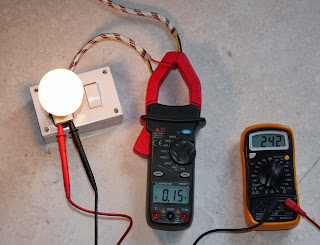Measuring the hot resistance and cold resistance of Incandescent Bulbs
The Bulbs
So I took 3 bulbs of 40 Watts, 60 Watts and 100 Watts respectively and measured the hot and cold resistancesI used the Philips softtone frosted lamp series.
Price:
40 Watts : Rs 20
60 Watts : Rs 20
100 Watts : Rs 21
 |
| Blub packs - Front |
 |
| Blub packs - Back |
Cold Resistances
The cold resistance readings were as follows:40 Watts : around 97.6 Ohms
60 Watts : around 71.4 Ohms
100 Watts : around 39.5 Ohms
 |
| Measuring Cold resistance of 40W Bulb |
 |
| Measuring Cold resistance of 60W Bulb |
 |
| Measuring Cold resistance of 100W Bulb |
Hot Resistances (Calculated)
Calculated values of hot resistance can be obtained using the formula: Resistance = (Voltage^2) / PowerIn India the AC voltage RMS value is 230 Volts.
So we get the hot resistances as:
40W Bulb : (230*230) / 40 = 1322.5 Ohms
60W Bulb : (230*230) / 60 = 881.67 Ohms
100W Bulb : (230*230) / 100 = 529 Ohms
Hot Resistances (Measured)
We can assume the AC mains voltage to be constant at 230Vrms but it does vary from place to palace, so I connected a multimeter in parallel with the bulb contacts to measure the voltage too.
The measured values are:
40W Bulb : 242 / 0.15 = 1613.33 Ohms
60W Bulb : 241 / 0.23 = 1052.17 Ohms
100W Bulb : 241 / 0.39 = 617.95 Ohms
 |
| Measuring the hot resistance of a 40W Bulb |
 |
| Measuring the hot resistance of a 60W Bulb |
 |
| Measuring the hot resistance of a 100W Bulb |
Measuring the power directly using a digital energy meter
Now days small digital energy meters are available which can measure power consumed by a single device during a period of time. In India, you can get one from Visha Electronics, Mumbai (http://www.vishaworld.com/). I just wanted to check by how many watts did the value of the actual power consumed vary from the one printed on the box.
40W Bulb : 42.9 Watts
60W Bulb : 64.1 Watts
100W Bulb : 104 Watts
60W Bulb : 64.1 Watts
100W Bulb : 104 Watts
 |
| Measuring the power consumed by a 40W Bulb using a digital energy meter |
 |
| Measuring the power consumed by a 60W Bulb using a digital energy meter |
 |
| Measuring the power consumed by a 100W Bulb using a digital energy meter |








Awsome! Great post, very clear and thorough. Makes understanding much simpler without the heavy duty mathematical equations. What would have been nice would be a graph showing the wattage, voltage, current, and resistance values migrate up, or down. Maybe I'll try to tackle that after your great enlightenment post. Thank you very much from San diego California USA.
ReplyDeleteWhats the difference between hot and cold resistance?
ReplyDeleteGood to know, I was trying to work out a bulb wattage by measuring the resistance of the filament, and was confused why the reading was 50ohm cold reading on a 250 volt supply that would have been almost 1kw, that's impossible for a G9 bulb as they only make them up to 60 watts. My sanity is now restored after reading this useful information. Thank you.
ReplyDeletei was myself confused while trying to measure the inductance of a coil in series with a bulb by measuring the potential drop across the bulbs and the inductor... the resistivity of the element of bulb changes with temperature at a very high rate ... it has low resistivity on low temperatues.. this is so that even at low voltages power consumed Vsqr/R remains high and we get a more glowing effect even at low voltages
ReplyDeletereally helpful. thank you ! <3
ReplyDelete